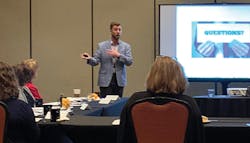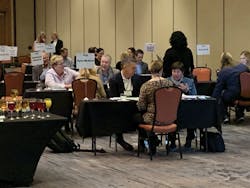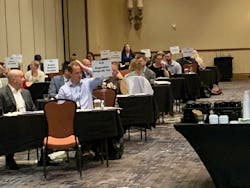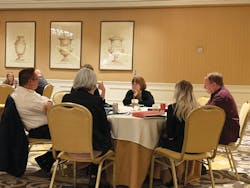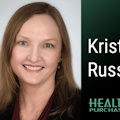The second annual Endeavor OR Leadership Summit, in collaboration with Healthcare Purchasing News (HPN) was held in January in St. Augustine, FL. The attendees for these Summits are invited from the HPN subscriber audience of OR Directors who are involved in their hospital surgical centers and OR operations, as well as control inventory of supplies through purchasing and management.
The OR Leadership program provides attendees with the opportunity to network and engage with senior-level decision-makers from healthcare systems that typically serve hospitals with 100 beds or more. The Summit is a unique way for attendees to learn from professionals who are in similar positions at their own facilities.
Before the Summit, HPN asked OR Directors to tell us about their major concerns regarding operations, staffing, new technology adoption and visibility that affect their efficacy in delivering quality surgical services and OR results. Based on this information, we created in-depth questions on topics and concerns that were mentioned most frequently by the attendees.
The meeting venue and schedule is designed to optimize the interaction between the attendees, as well vendor sponsors who are able to share meals and conversations with most of the attendees. The attendees have the opportunity to network at numerous roundtable discussions that HPN prepared, as well as meet with solution providers in the industry at Small Group Presentations, One-to-One meetings and multiple networking events.
The biggest difference between our Summit and other meetings is the quality time provided for networking, which results in problem solving and information sharing between peers.
We’ve shared some of the best practices from the Round Table discussions:
Building an effective or team culture
Is your OR team focused on the task at hand and humming with good energy? If not, why do you think that is? If you answered yes, share your strategy for building a strong OR team culture. Discuss the changes that were made, how they were implemented, and any tools used to create a more positive and collaborative environment.
This group identified a number of elements of culture issues for which OR directors feel support is lacking:
- Leadership changes with no structured communications regarding the changes.
- A toxic culture – bullying among staff.
- Coordinators and charge nurses not leading by example.
- A mentality that holds people accountable, but not for “me”.
- Physician behavior.
- Lack of accountability for KPIs.
- Lack of support for OR directors from C-Suite.
- Private practitioners not adhering to best practices.
- Cellphones: The RNs carry the cellphones, but you (OR Director) can’t gauge if they are on social media or not. Write the policy that you can carry them, but you can’t use them. Use internal way of communication.
- Generation gaps: Older RNs may be challenged by ve, so consider creating programs that develop crossover between age gaps.
What effective strategies have you tried that received positive results:
- We over me = team building initiative.
- Department leaders taking leadership courses.
- Give staff “core values card” so that all staff make a commitment to the department.
- Follow-up plan development with problem employees.
- Shared governance with guidance.
- Develop employee recognition programs that are meaningful.
- Work improvement plans.
- ‘Crucial conversation’ classes teach communication skills that may help align and foster agreement around potentially emotional or difficult topics – typically behavior, training, etc.
- Set department guidelines and hold to them.
- Put the right people in the right positions.
- Develop Formal versus Informal teams. Formal teams are structured and created for a specific purpose; a delegated leader and everybody within the team has a distinct role, for example, to solve a piece of the workflow. An informal team has no structure and equal status among members, for example, to organize a weekly lunch to share ideas.
- Develop shared governance that includes attendants, RNs, and Surgical Technology managers to help facilitate OR operations. Also task RNs from each department to hold monthly meetings to discuss surgical services issues.
- Rebuild trust in your teams through TEAMSTEPPS - (Team Strategies and Tools to Enhance Performance and Patient Safety) which is a systematic approach developed by the Department of Defense (DoD) Patient Safety Programs and the Agency for Healthcare Research and Quality (AHRQ) to integrate teamwork into practice. It is designed to improve the quality, safety, and the efficiency of healthcare. The core of the TeamSTEPPS framework is comprised of four skills: Leadership, Situation Monitoring, Mutual Support, and Communication. The program is rooted in more than 20 years of research and lessons from the application of teamwork principles. https://www.ahrq.gov/teamstepps/index.html
- Assess the Need - Align a CNO, Medical Director.
- Partner with Infection Control, Quality. They need to see the bottom line. An Antibiotic Resistant Organism (ARO) program should be initiated.
- Use SBAR - Situation, Background, Assessment, Recommendation. SBAR can help deliver the Safe delivery of care, which may be compromised in the absence of clear, complete and respectful communication.
- Providing the right care to the right patient at the right time (provide the right care to the right patient at the right time.)
- Periop 202 is essential nurse education for specialty surgical procedures from AORN – good to promote this program.
- Education is the key to self-promotion.
Preventing employee burnout while increasing engagement
Burnout is a fact of life for most surgical employees but there are ways to lessen the burden and keep staff engaged in their work. Is your leadership style conducive to making staff feel comfortable discussing burnout? Share some of the programs or incentives that you’ve introduced to help motivate staff, ease stress and keep them productive.
Suggestions for engagement enhancement while relieving burnout:
- Encourage nurses to find something in the present such as yoga, reading, or any hobby that helps them turn off work.
- Model the work-life balance.
- Give employees accountability, autonomy; let them own their practice.
- Review your nursing engagement - with the NDNQI (National Database of Nursing Quality Indicators), a national nursing quality measurement program that allows hospitals to compare their performance and nursing quality with hospitals of the same type and size, down to the unit level.
- Give staff bonuses or other incentives for meeting targets.
- Financial incentive transparency - share the bonus by unit level, or per hospital for larger systems.
- Offer tranquility and reflection rooms.
- Recognition luncheons.
- Celebrate all of the Periop weeks
- Points system–trade for treats, lunch, etc.
- Recognition board. Develop a board that is visible and offer small gifts that tie back to evaluations.
- Vision board – administration visualizes the board with staff.
- Flex shifts to meet department and staff needs.
- Unit practice councils to give input on changes.
- Support services – On-site child care, Free parking, shuttle service.
- Daily huddles.
Overcoming challenges with block schedules and room utilization
The pressure is always on to keep cases moving – and the more the better. Unfortunately, procedures are frequently delayed, and rooms underutilized. What disrupts your flow? Today’s scheduling systems have been shown to help avert these issues for many facilities. Are you happy with your system – why or why not – and what has your team done to improve scheduling and utilization problems?
Challenges of Block Scheduling:
Surgeons -
- Under scheduling cases and then running over block time.
- Looking at scheduling system – accurate data.
- All MDs wanting to work on same day.
- Anesthesiology -
- Limiting factor to run rooms at the end of the day.
- Co-management and financial incentives.
- Solutions:
- Evening and night shifts to help scheduling.
- Physicians required to show utilization prior to being awarded block time.
- Physician Utilization scores posted publicly to their block schedules.
- Consider Saturday schedules.
- For underutilized block schedules – consider freezing or eliminating block schedules for that physician.
- Add pay-per-performance metrics.
- Add additional anesthesia locations – for endoscopy, EP/cath lab, etc.
- Triad/Triumvirates – Delegate a leader team to work together with anesthesia/nursing/surgeons on decisions such as block time rules and data gathering, analyzing, sharing.
- Get together on staffing alignment. For example, anesthesia and nursing shifts may need to be 10 or 12 hours each to close cases.
Improving operating room turnover and workflow efficiency
Strong interdepartmental relationships are key to successful room turnover and workflow success. How well does your OR and environmental services staff work together to achieve greater efficiencies? Are you familiar with the tasks they perform? Do you understand their processes and how certain products are used to disinfect rooms and prep for the next case?
Solutions:
- EVS – allocate staff to various specialties and focus on the training needed for that specialty.
- Take a Swim lane approach by delineating tasks for the staff who clean and for additional staff to understand that role and where to help. Developing a swim lane workflow can provide a sense of order to a busy OR (aka Pool). A swim lane diagram organizes the information and places that data in categories and develops a flowchart that can provide additional clarity by placing process steps into ‘swim lanes’ or lines of action.
- Education programs, for example, AORN offers certification for “turnover techs.”
- A Surgeon who leads and inspires the team during setups.
- Clinical Monitoring program for the OR. Consider an organizational program that shows the room times; when cases are finished, when next patient is scheduled in that same OR, etc. Alerts EVS when to come to room. There are “Cockpit” programs available that provide visibility, and modules to show timing of events in OR.
- Use Turnover Kits but review the one your team uses to ensure it is beneficial and economical. There are a number of different types.
Challenges:
- Silos with staff duties – “I don’t touch that…”
- Different EVS people are assigned roles that frequently aren’t involved with OR turnover due to short staff. Training is needed.
- Supervisor of staff in EVS not visible.
- No Turnover time per case specialty identified and it varies greatly.
- PACU (post-anesthesia care unit) pulls patients in real time and prepares beds for them before they are ready to move onto the floors. At one hospital doing total joints, the PACU RN came to get patient, which they found to be the best practice.
- Clearly identify roles of any available personnel and their role in the turnover process.
- PACU backup from floor bed space (biggest challenge).
Parallel processing is imperative.
Innovative tools and strategies for enhancing patient satisfaction
Keeping surgical patients safe and satisfied before and after a procedure can be challenging. How have patient expectations changed in recent years? How well does your department score on patient surveys? Has the HCAHPS initiative made your job harder – why or why not? Can you point to any particular products or clinical practices that have helped you to enhance patient satisfaction?
Enhancements:
- Are we meeting your expectations? Use HCAHPS that are visible to all staff to view. The HCAHPS (Hospital Consumer Assessment of Healthcare Providers and Systems) survey is a national, standardized, publicly reported survey of patients’ perspectives of hospital care. HCAHPS, also known as the CAHPS Hospital Survey, is a survey instrument and data collection methodology for measuring patients’ perceptions of their hospital experience. While many hospitals have collected information on patient satisfaction for their own internal use, until HCAHPS there was no national standard for collecting and publicly reporting information about patient experience of care that allowed valid comparisons to be made across hospitals locally, regionally and nationally. https://www.cms.gov/Medicare/Quality-Initiatives-Patient-Assessment-Instruments/HospitalQualityInits/HospitalHCAHPS
- HRO huddles—Create a high reliability organization (HRO) that is able to consistently reduce the number of expected or “normal” accidents. This happens through culture change, technology-despite a highly unpredictable hospital environment.
- Offer Clear carbohydrate drinks to patients.
- Keep the patients involved in education process on their status with hourly rounding.
- Change nonverbal communication by nurses. Talk about mission, vision and values to patient.
- Pharmacy delivery service through the hospital pharmacy or pharmacy delivery services.
- One-stop shop – 24/7 scheduling center to find appointment.
- Use staff who are not afraid to share help.
- Use scripting to train nurses and discharge nurses so communications are complete.
- Loop anesthesia into training and patient satisfaction.
- Discharge calls for post-op patients to follow up.
Keeping up with changes in equipment, technology and standards
Are you working in a state-of-the-art surgical theater or still wishing you were? If you could choose five pieces of equipment, surgical devices, instrumentation or any other innovative technology, what would you request and why? If you already work with the latest technologies, are they worth the hype? How do they help to improve outcomes, efficiencies, job satisfaction, etc.? Were there any challenges during implementation? Was staff adequately trained, and do they feel confident in their ability to operate the technology properly?
Product Evaluation:
- New products, technology come out everyday. Do facilities have a person dedicated to keep up with changes, recommendations, etc.?
- Have someone or teams go to conferences, trade shows to see products and decide if a trial or cost effectiveness would benefit.
- County/VA-run hospitals have a greater challenge with more hoops to jump through because of who the decision makers are for their hospitals.
- GPOs can be a challenge getting products on contract.
- When agreements are made on new products or equipment, meet with the vendor on training and set up a schedule for vendors to come in on a scheduled, regular basis for proper training. Schedule in-services to cover all shifts.
- Ensure IFUs come with products
- Check all details of service contracts
- If videos are available, make them available for staff
- IT issues can be challenging
- - Having IT do the extra work of installing – scheduling issues
- - Interoperability - systems that will work together
- - WIFI issues when going wireless
- - Firewall issues
- - IT department untrained and not able to get all the functionality working
- Develop a system that includes a checklist for all entities involved (physician, nursing, CS/SPD, IP, etc.) and send out for discussion on the product prior to purchasing.
Cleaning Concerns:
- Check AORN guidelines and IFUs used for new equipment
- If an IFU is unavailable or an in-service on cleaning an instrument isn’t available, don’t put that product into use.
- Involve infection control in the beginning of the product evaluation for cleaning procedures and chemicals to be used.
- Military hospitals, VA, County, Corporate hospitals all have different chain of command for bringing in different equipment and getting approved.
- Develop a system that includes a checklist for all entities involved (physician, nursing, CS/SPD, IP, etc.) and send out for discussion on the product prior to purchasing.
Effective strategies and tactics for reducing waste, loss and costs
Cost-containment efforts are a universal undertaking in healthcare systems everywhere and efforts to reduce costs can be made in dozens of areas using a variety of best practices and technology. Where is spend highest in your OR? Can you pinpoint what’s causing it? What do you think is needed – and where is it needed – to curb unnecessary spending?
Is it needed?
- Review Preference cards
- Instruments – are they all necessary, used?
- Packs – Reduce the amount of items by reviewing what comes back unused.
- Develop programs to decrease loss of scrubs such as; no scrubs allowed to leave the building, RFID tags, Scrub vending machines.
- Consider eco-friendly reprocessing programs. Any unused, non-contaminated items can be sent to places like animal shelters – low cost to organization and gives back to the community
- Use an instrument tracking system to track usage, and for future preventive maintenance scheduling.
Strategies for recruiting and retaining quality staff
Are you having difficulty attracting and keeping highly-qualified surgical staff or have your recruiting efforts been a success? What do OR staff want and need to feel satisfied? If this is a pain-point for you, consider some small steps you could take right now to improve retention, as well as ideas that might need to be further developed into a formal policy requiring C-suite buy-in.
Top tips – more money, more flexibility:
- Bonuses for sign-on: RN – up to $12k (2-year commitment); CST – up to $15k (2-year commitment).
- Bonuses for retention : RN - $7k (2-year commitment); CST – 5k (2-year commitment).
- Lifestyle call. Develop a Sunday night to Friday morning shift. Consider establishing a 7 pm - 7 am separate team that covers late cases and early setups.
- Consider a shift crew that covers weekends or a weekend crew paid incentive.
- Add a Cafeteria on the same floor as OR to help with staff satisfaction, and the problem of short breaks.
- For late case completion, consider a bonus of $25.00/hour for an RN that stays extra hours, consider a bonus for surgical techs also.
- Offer a new grad OR internship
- Add Educators but they must be visible ½ circulator / ½ admin
- Bring new staff together after they are off orientation for 1 month to renew and network.
- Give $500 bonus to a nursing preceptor who helped train a new orientee who stays six months.
- Offer Clinical ladders that offer additional clinical interest areas and cross training incentives.
- RN residency program
- Tuition reimbursement – 2 year commitment
- Consider a temp Agency to support team until new staff oriented, trained.
- Encourage nurses with strategies to further education when talent is recognized
Wrap it up till next year
There were many more questions and discussions that covered outreach, safety and cleaning, adoption concerns, just to name a few. The OR Directors voiced happiness with the conference value. Many said they learned more in 2 days than many other events. The sponsors said they were happy with the quality of the interaction with OR Directors and in particular with their ability to have One-to-One meetings. Our next Annual Lab Directors Summit will be in January 2021.
We’re also launching an Infection Prevention Directors Summit in September 2020. Let us know if you are interested at [email protected].
About the Author
Kristine Russell
Publisher Emeritus
Kristine Russell is Publisher/Executive Editor, Retired
Healthcare Purchasing News, EVP, Healthcare Division, Endeavor Business Media LLC.
